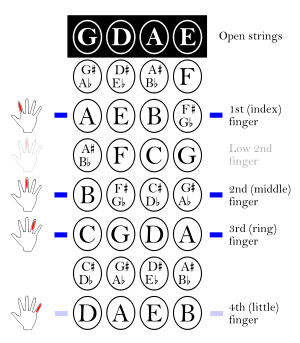
Stopped note
Encyclopedia
Bowed strings

String instrument
A string instrument is a musical instrument that produces sound by means of vibrating strings. In the Hornbostel-Sachs scheme of musical instrument classification, used in organology, they are called chordophones...
s, a stopped note is a played note
Note
In music, the term note has two primary meanings:#A sign used in musical notation to represent the relative duration and pitch of a sound;#A pitched sound itself....
that is fingered with the left hand, i.e. not an open string, on the string
Strings (music)
A string is the vibrating element that produces sound in string instruments, such as the guitar, harp, piano, and members of the violin family. Strings are lengths of a flexible material kept under tension so that they may vibrate freely, but controllably. Strings may be "plain"...
being bowed
Bow (music)
In music, a bow is moved across some part of a musical instrument, causing vibration which the instrument emits as sound. The vast majority of bows are used with string instruments, although some bows are used with musical saws and other bowed idiophones....
by the right hand. This assists with tone production
Timbre
In music, timbre is the quality of a musical note or sound or tone that distinguishes different types of sound production, such as voices and musical instruments, such as string instruments, wind instruments, and percussion instruments. The physical characteristics of sound that determine the...
, the addition of vibrato
Vibrato
Vibrato is a musical effect consisting of a regular, pulsating change of pitch. It is used to add expression to vocal and instrumental music. Vibrato is typically characterised in terms of two factors: the amount of pitch variation and the speed with which the pitch is varied .-Vibrato and...
, and sometimes additional volume
Dynamics (music)
In music, dynamics normally refers to the volume of a sound or note, but can also refer to every aspect of the execution of a given piece, either stylistic or functional . The term is also applied to the written or printed musical notation used to indicate dynamics...
but creates difficulty in that bowed string instruments do not have fret
Fret
A fret is a raised portion on the neck of a stringed instrument, that extends generally across the full width of the neck. On most modern western instruments, frets are metal strips inserted into the fingerboard...
s, requiring ear training
Ear training
Ear training or aural skills is a skill by which musicians learn to identify, solely by hearing, pitches, intervals, melody, chords, rhythms, and other basic elements of music. The application of this skill is analogous to taking dictation in written/spoken language. Ear training may be...
and accurate finger placement. The lack of frets, as on the guitar fretboard, does allow greater variability in intonation
Intonation
Intonation may refer to:*Intonation , the variation of tone used when speaking*Intonation , a musician's realization of pitch accuracy, or the pitch accuracy of a musical instrument*Intonation Music Festival, held in Chicago...
though a bowed string instrumentalist, such as a violinist, "when unaccompanied, does not play consistently in either the tempered
Equal temperament
An equal temperament is a musical temperament, or a system of tuning, in which every pair of adjacent notes has an identical frequency ratio. As pitch is perceived roughly as the logarithm of frequency, this means that the perceived "distance" from every note to its nearest neighbor is the same for...
or the natural scale
Just intonation
In music, just intonation is any musical tuning in which the frequencies of notes are related by ratios of small whole numbers. Any interval tuned in this way is called a just interval. The two notes in any just interval are members of the same harmonic series...
, but tends on the whole to conform with the Pythagorean scale
Pythagorean tuning
Pythagorean tuning is a system of musical tuning in which the frequency relationships of all intervals are based on the ratio 3:2. This interval is chosen because it is one of the most consonant...
"

| Open | Stopped |
| Easy to play | More technically demanding |
| No vibrato available | Vibrato and multi-expression available |
| Essentially fixed pitch | Unlimited ability to adjust intonation |
| Notes are full and bright | Notes are slightly less resonant |
| Tone color may be brash, not blending well | Tone color is controllable, and may be more uniform |
| Pizzicato Pizzicato Pizzicato is a playing technique that involves plucking the strings of a string instrument. The exact technique varies somewhat depending on the type of stringed instrument.... notes sustain longer |
Notes are shorter when plucked |
| Easier to play two notes | Double-stops Double stop A double stop, in music terminology, is the act of playing two notes simultaneously on a melodic percussion instrument or stringed instrument... are harder, but blend better |
Fingered tremolos, the rapid alternation of two notes, are best between two stopped notes on one string, in which case it is limited to the interval of an augmented fourth, or between stopped notes on two adjacent strings:
Plucked strings
On plucked string instruments with frets such as the guitar a stopped note is a played note that is fingered with the left hand, i.e., not an open string, on the strings being plucked or strummed by the right hand.Horns
HornHorn (instrument)
The horn is a brass instrument consisting of about of tubing wrapped into a coil with a flared bell. A musician who plays the horn is called a horn player ....
players refer to "stopped notes" as notes played with the stopping hand placed further into the bell than usual.

